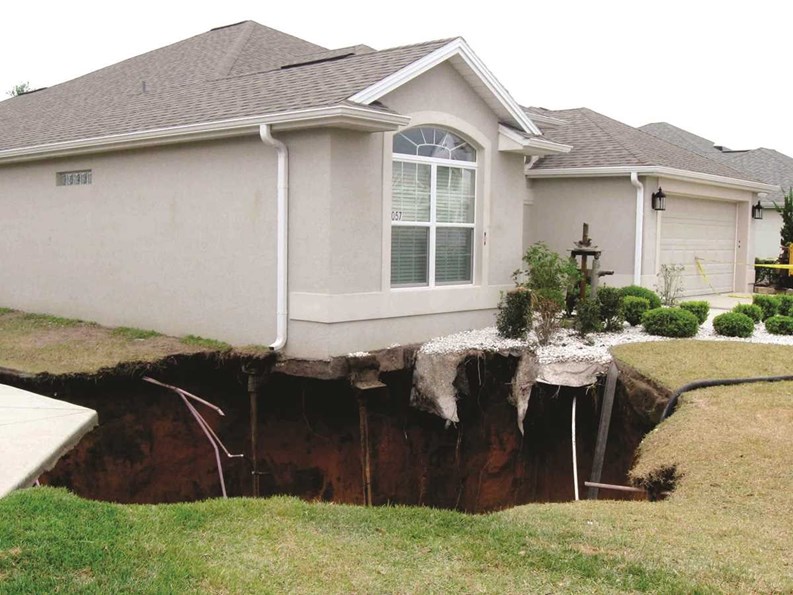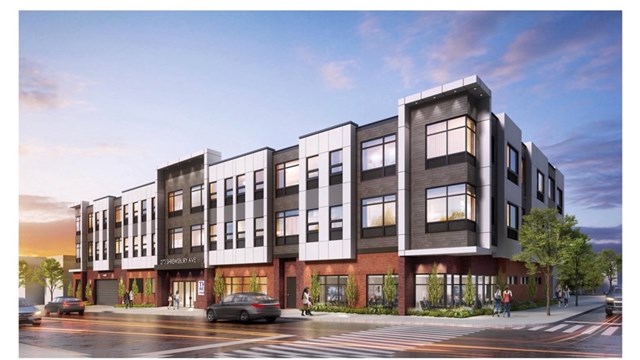It's a nightmare scenario; you're at home—maybe even sound asleep in your bed—or perhaps just walking down the street, and all of a sudden, the ground beneath you literally opens up, swallowing homes, cars, trees and even people into a muddy, seemingly bottomless pit. If you're in California, you might attribute such a catastrophe to an earthquake, but in Florida, chances are you've just witnessed—or been the victim of—a sinkhole. Some regions of the country are prone to sinkholes because of their geologic makeup, including some parts of New Jersey.
The Hole Story
The first thing you need to know about sinkholes is that there are two different kinds. The one where the ground opens up and houses fall in, like in a horror movie? That’s called a cover collapse sinkhole, and they are—thankfully—relatively rare. “Large scale sinkholes are very rare in the Northeast,” says Thomas Roman, owner and president of Quality 1st Contracting in Cliffwood. “I’m not familiar with any here in New Jersey that have swallowed up anything. It’s been over 25 years since we’ve seen anything like that.”
The other—and by far more common—type is a subsidence sinkhole. This is when water gradually erodes the layer of sedimentary rock below the surface. The most famous example is the sinkhole beneath the Leaning Tower of Pisa, which modern Italian engineers have managed to arrest…but not arrest so much that the wonder of the world loses its trademark tilt. Subsidence sinkholes can be shored up—or at least made more safe.
“The soluble formations in New Jersey are limestone and dolomite,” says Richard Dalton, a geologist with the New Jersey Geological & Water Survey. “In the southern part of the state we have a formation called the Vincentown, which is a calcarious sand—it’s broken-up shell material. If sinkholes occur there, they’re generally shallow little depressions, maybe a foot deep. There have never been any documented catastrophic sinkholes down there.”
The natural sinkholes, however, tend to cluster in the northern—and more populous—part of the state. “If you look at a geologic map of the state, the main areas are Sussex, Warren, parts of Hunterdon, parts of Morris County, a little bit in Passaic County, and there are some limestones in Somerset County,” Dalton explains. “If you are in a limestone area, and you walk the property, look for shallow depressions that are dish- or funnel-shaped.”
Dig Your Own Hole
For all the geological quirks of the region, most of the sinkholes of New Jersey are, perhaps surprisingly, of man-made origin.
“The sinkholes that a condo building or a community in New Jersey will see are mainly related to drainage,” says Roman. “They’re normally in the area of catch basins or where drainage pipes run underground. In most cases they can be tracked to a failure of those underground pipes or catch basins, which allows the soil to drain down and create a sinkhole. Often it’s poor workmanship at the time of installation that's to blame.”
Stewart Willis, HHS, RS, Northeast regional senior vice president at Falcon Group Engineering, an architecture and energy consulting firm, agrees. “Our specific experience normally has to do with sinkholes that are caused by improper fill or backfill practices during site construction. During rough grading and land clearing operations for a new community, organic materials like tree stumps are sometimes not properly removed, and get buried. They continue to break down over time, and that can cause a collapse or a sinkhole condition.”
These organic material sinkholes are fairly common, unfortunately, due to a bad practice from many years ago. “In the past, it was standard to push all this organic debris into something they called a ‘garbage hole’ and bury it,” says Roman. “And you’d have tree debris, and different organics that would be dumped into the hole and filled with dirt. And over time, all that material would start to rot away and depress, and that would create sinkholes. There was one in North Brunswick about ten years ago that encouraged the creation of laws and codes to prevent burying debris like that.”
And it's not always organic debris that causes problems. One of the challenges in repairing sinkholes is that even when caused by similar conditions, no two holes are exactly alike. “Every sinkhole has its own unique story in terms of how it got there,” says Willis. “There are all kinds of things that can start the process. Some of the scarier ones are where the middle of Main Street opens up and a car gets swallowed up by a crater. Those are usually caused by a leak in a storm sewer. It’s just been washing away the soil for so many years, until all of the sudden you’ve got this void, and then one day it decides to collapse. And then you have the classic geological sinkholes, which occur due to a dissolution of rock by water. Ancient carbonate formations are dissolved by actively moving water. They do occur in New Jersey, though more so in the northwest part of the state, and certainly in eastern Pennsylvania.”
Other Factors
There are naturally-occurring sinkholes, and those caused by construction or land-moving projects...and then there are the ones that form as a direct result of people themselves. New Jersey is not a big state, but a lot of people live here—most of them in the north, where the sinkholes tend to be. All of those people, and all of those homes and places of business, have an effect on the local geology.
“Even naturally occurring formations can be aggravated by man-made activity, including the building of roads and highways,” Willis points out. “The earth-moving activity of this kind of construction and development tends to concentrate where the storm water collects. This can increase the rate of dissolution of these carbonate rock structures in the ground, and all of a sudden new voids are formed.”
That’s why proper drainage is so critical to avoiding sinkholes.
“Another very important step is to make sure the surface drainage, like around the structure, is piped away from the building,” says Dalton. “In Washington Township, a number of years ago, a builder built some houses, and the downspouts aimed right down along the foundations. And all the rainwater going down percolated through the soil, and the limestone had some voids in it and eventually they had collapses right up against the houses and driveways. So the management of the water on the site is the most important thing.”
I'm Fixing a Hole...
So what do you do if you notice that land on your property is sinking or shifting?
“This is actually quite commonplace up and down what we call the ‘Gold Coast’ of New Jersey, which is Hudson County: Hoboken, Jersey City, Weehawken and West New York,” says Willis. “There’s been a lot of land development down along the Hudson riverfront over the last 20 years, and it’s ongoing today. This has been a particular challenge, because a lot of what is now land used to be colonial landfill, as well as river silt and sediment and a lot of organic material. We’ve been involved with a lot of differential building settlement and sinking issues over there.”
For any number of reasons, fixing sinkholes and the structures affected by them is tricky work. “You have to call in engineers and geotechnical consultants to do the same types of soil borings you would normally do before construction, but do them after the fact. We take those subsurface samples and see what the issue is. When we take soil samples from along the riverfront on the Gold Coast, we generally don’t pull up gold; we pull up garbage. It’s all kinds of stuff that you can’t just build a conventional footing on. Some of the developers were smart, and built on deep-pile foundations, and they’re okay. But we’ve had other buildings that just sort of went in there with conventional shallow-spread footings, and they ran into big problems where the building literally started to sink into that organic stuff. And hopefully the building hasn’t gotten so bad that you can’t save it by underpinning the existing building with retrofit foundation reinforcement.”
Dalton, the geologist, explains the procedures for identifying, preventing, and repairing sinkholes. “Over a number of years, we’ve worked with a group called North Jersey RC & D, which is part of the old national soil conservation service, and we’ve worked with a lot of North Jersey towns to develop a model sinkhole ordinance. So people in limestone areas will know if there are sinkholes, or sinkhole potential, on their property. If the town has this ordinance, builders have to take certain steps before construction. First they search aerial photos of the property, looking for evidence of sinkholes. If they are noted, the next step would be to drill some borings to find out if there are any voids in the soil or in the bedrock under the property. And then the consultant would develop a remediation procedure, which could be grouting up the voids in the rock with a mixture of cement and water and they would seal them near the soil-rock interface.” (The engineers who prevented the Leaning Tower of Pisa from becoming a ruin used this method, cutting into the ground with pipes, and then injecting a watery grout mixture into the recesses.) “Sometimes they’ll use heavy equipment, such as dropping a weight to collapse the soil down, and make it very compact to stop any voids from forming,” Dalton continues. “Then they can go ahead and build.”
As the Leaning Tower of Pisa—as well as the sinkholes that make the news for their destructive, even devastating effect—have demonstrated, the structures we build are always susceptible to Mother Nature’s whims. By knowing the conditions and warning signs of a possible sinkhole, your building or community can take steps to head off disaster, saving money, property, and maybe even lives.
Greg Olear is freelance writer and a frequent contributor to The New Jersey Cooperator.







Comments
Leave a Comment